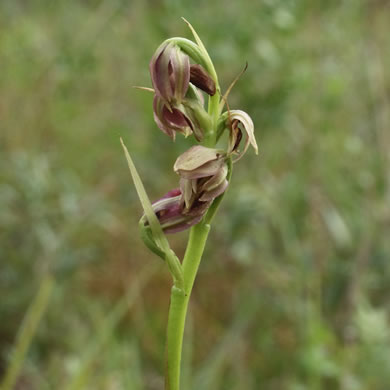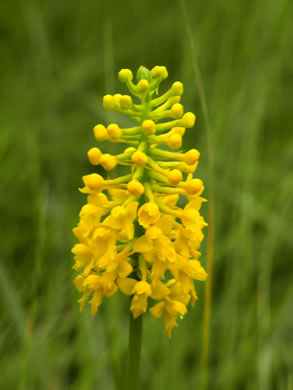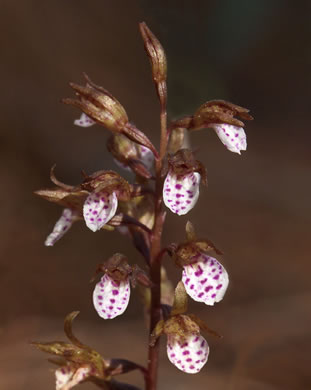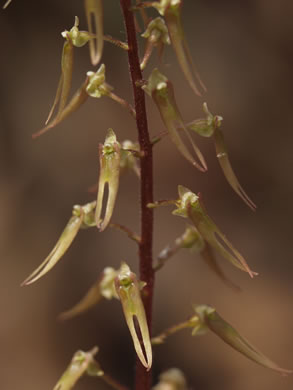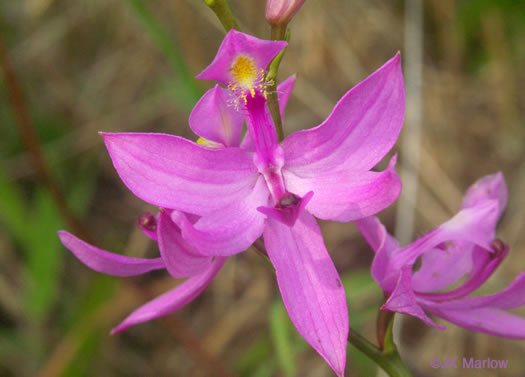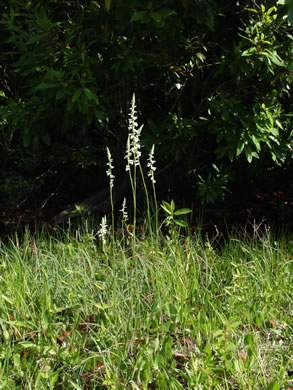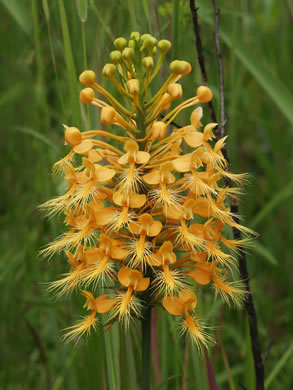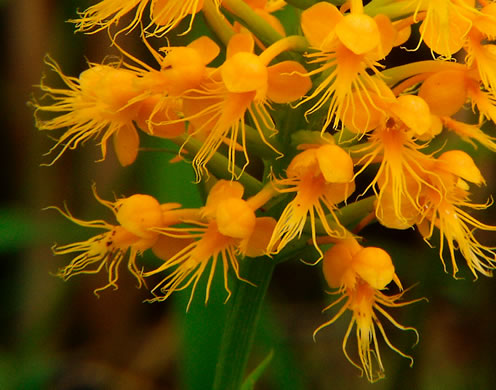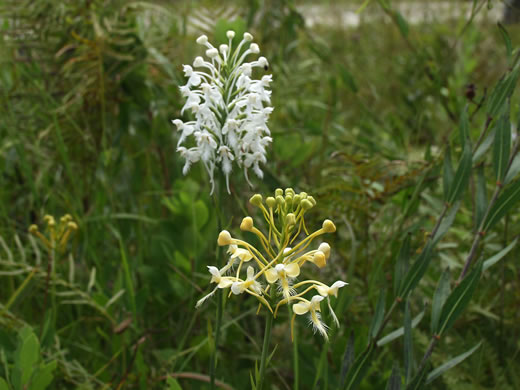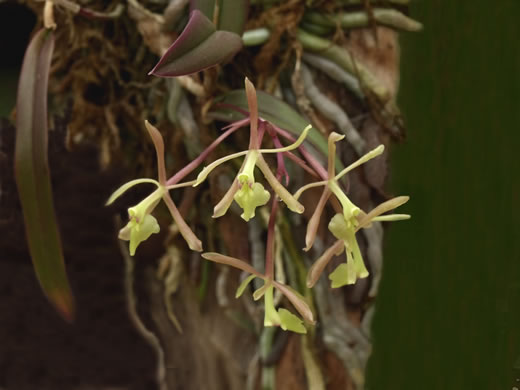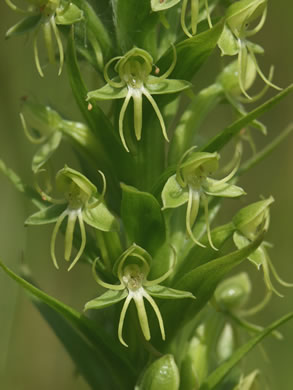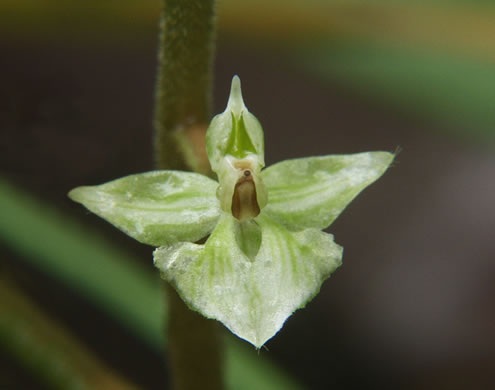Orchids of
the Francis Marion National Forest
Berkeley County, South Carolina
by James Alexander Fowler*
Reprinted from the April 2007 Journal of the South Carolina Native Plant Society, and used by permission.
To see pictures or additional information about a particular plant, click its name.
The Francis Marion National Forest (known by locals as the Francis Marion) is a popular destination for botanists, especially for those interested in orchids and carnivorous plants. It comprises about 250,000 acres of mixed hardwoods, bottomland swamps, and longleaf pine savannahs. It contains some unique geological features known as Carolina Bays. These bays are shallow oval depressions (their origin is still hotly debated) that make excellent habitat for many rare and unusual plant species, including about two dozen of South Carolina’s fifty-five native orchid species and hybrids.
Platanthera conspicua (southern white fringed orchid) and Platanthera xlueri (Luer’s hybrid fringed orchid)
The largest portion of the Francis Marion is located in Berkeley County, the rest being in adjacent Charleston County, in the southern portion of coastal South Carolina. It is criss-crossed by hundreds of sandy, one-lane USFS roads that wind through areas with names like Hellhole Swamp, Dog Swamp, Florida Bay, Tiger Corner, and Yellow-jacket Island, and offering views of dense pocosins and vast longleaf pine savannahs. These local names bring to mind the many seemingly impenetrable areas of boot-sucking mud, chiggers, ticks, mosquitoes, leeches, snakes, and alligators. But, we never let those minor inconveniences hold us back, do we?
Steed Creek Road is a paved two-lane road that runs North/South through the center of the Forest. But, to those of us who know it well, it is called Orchid Alley. All along this road, in the ditches and roadside banks, one can find many of the common species of orchids that bloom in the Francis Marion.
That is quite a sight, especially in the spring and early summer when the pinks of Cleistes divaricata (spreading pogonia) and Pogonia ophioglossoides (rose pogonia) and the magentas of the Calopogon species are at their best.
In the fall, the orange, white, and yellow torches of the fringed orchids hold court along those same roadside banks, sometimes in the hundreds.
Before Hurricane Hugo, the Francis Marion was one of the pre-eminent longleaf pine holdings in the southeastern United States. In 1989, that hurricane came inland in the central portion of the Francis Marion and destroyed many thousands of mature longleaf pines and live oaks. This turned out to be a two-edged sword, since it also opened up many areas that had previously become choked with deciduous trees and shrubs. In looking at practical ways to bring back the longleaf pine forest, the US Forest Service undertook a serious program of prescribed burning as a way to control the growth of undesirable species. Many of the orchid species we all love not only do well under prescribed burn regimes, but several species actually require regular burning in order to come back year after year.
Two of the orchid species in the Francis Marion that require burning of competitive vegetation are Pteroglossaspis ecristata (crestless plume orchid) and Gymnadeniopsis integra (yellow fringeless orchid). Both species seem to completely disappear within two or three years after a burn if the burns are not repeated. It is thought that the plants resort to dormancy or produce minor vegetative growth during the inter-burn period, apparently waiting for the vegetative competition to be removed. Both of these species are quite rare in the Francis Marion, and it is quite a pleasant surprise to come across these beauties in bloom.
The first orchids to bloom in the Francis Marion are Listera australis (southern twayblade) and Corallorhiza wisteriana (Wister’s coralroot). Both can usually be found blooming during late February thru early March. The flowers of Listera australis are usually some shade of greenish or brownish red, but also can be found in shades of tan or yellow. Regardless of the flower color, the plants are quite difficult to see in the leaf and pine needle litter on the forest floor. Depending upon the timing of annual burns, you might be lucky enough to find Calopogon multiflorus (many-flowered grass-pink) blooming several weeks after March or April burns, although this particular species has not been seen there for several years.
There are two seasons when orchid flowering is most plentiful in the Francis Marion. The first is May-June. The species normally found then are
- Calopogon barbatus (bearded grass-pink),
- Calopogon tuberosus (common grass-pink),
- Calopogon pallidus (pale grass-pink),
- Cleistes divaricata (spreading pogonia),
- Spiranthes praecox (giant ladies-tresses),
- Spiranthes vernalis (spring ladies-tresses), and
- Pogonia ophioglossoides (rose pogonia).
My favorites of these are the Calopogon species, because of the wide variety of colors that the flowers exhibit, from pinks and magentas to the rare white form. Many of these colorful species are easily spotted from the road. Another summer species that has been recorded in the past is the very fragrant Gymnadeniopsis nivea (snowy orchid), but like Calopogon multiflorus, it has not been seen in several years.
The second orchid flowering season is August-September. This is when the Platanthera species are usually at their best. Included are
- Platanthera cristata (crested fringed orchid),
- Platanthera flava var. flava (southern tubercled orchid),
- Platanthera conspicua (southern white fringed orchid), and
- Platanthera ciliaris (yellow fringed orchid).
Since the latter two have overlapping bloom periods, it is not unusual to find their hybrid offspring, Platanthera xlueri (Luer’s hybrid fringed orchid).
Other species found blooming during this time are
- Epidendrum magnoliae (green-fly orchid),
- Habenaria repens (water-spider orchid),
- Tipularia discolor (crane-fly orchid),
- Triphora trianthophora (three birds orchid), and
- Malaxis spicata (Florida adder’s-mouth).
Epidendrum magnoliae is the only epiphytic orchid found in South Carolina, the remainder are terrestrial orchids. Epiphytic orchids grow on tree trunks or limbs. In the Francis Marion, Epidendrum magnoliae prefers to grow on live oak, swamp tupelo, or bald cypress.
In October and November, several other orchid species bloom and bring an end to the year’s orchid show. These species include Spiranthes cernua (nodding ladies’-tresses), the fragrant Spiranthes odorata (fragrant ladies’ tresses), and the unusual Ponthieva racemosa (shadow-witch orchid). The latter species prefers the highly basic soils that have resulted from paving the forest service roads with crushed oyster shells. The slightly acidic rainwater leaches out calcium from the shells and deposits it in the adjacent ditches, where Ponthieva racemosa thrives.
I find myself wanting to tell everyone I meet about the awesome native plants found in the Francis Marion National Forest, but am constantly reminded by the holes left by poachers that not everyone shares my ethic toward the environment. Fortunately, these illegal diggings are few and far between, but it does cause concern among those of us who love the Francis Marion and hope that it will remain the wild and natural treasure that it is.
* Jim Fowler is the author of Wild Orchids of South Carolina: A Natural History, and is currently working on a new book about orchids and carnivores of the Green Swamp in southeastern North Carolina.
SCNPS Journal editor’s note: Steed Creek Road, so aptly described by Jim as Orchid Alley, is under consideration for “improvement,” which includes adding lanes and deepening ditches. This will drastically alter the habitat in the vicinity of the road, and interfere with the currently active controlled burning program by USFS, which is so important to native habitats and wildlife. The South Carolina Native Plant Society is on record as opposing this plan.



